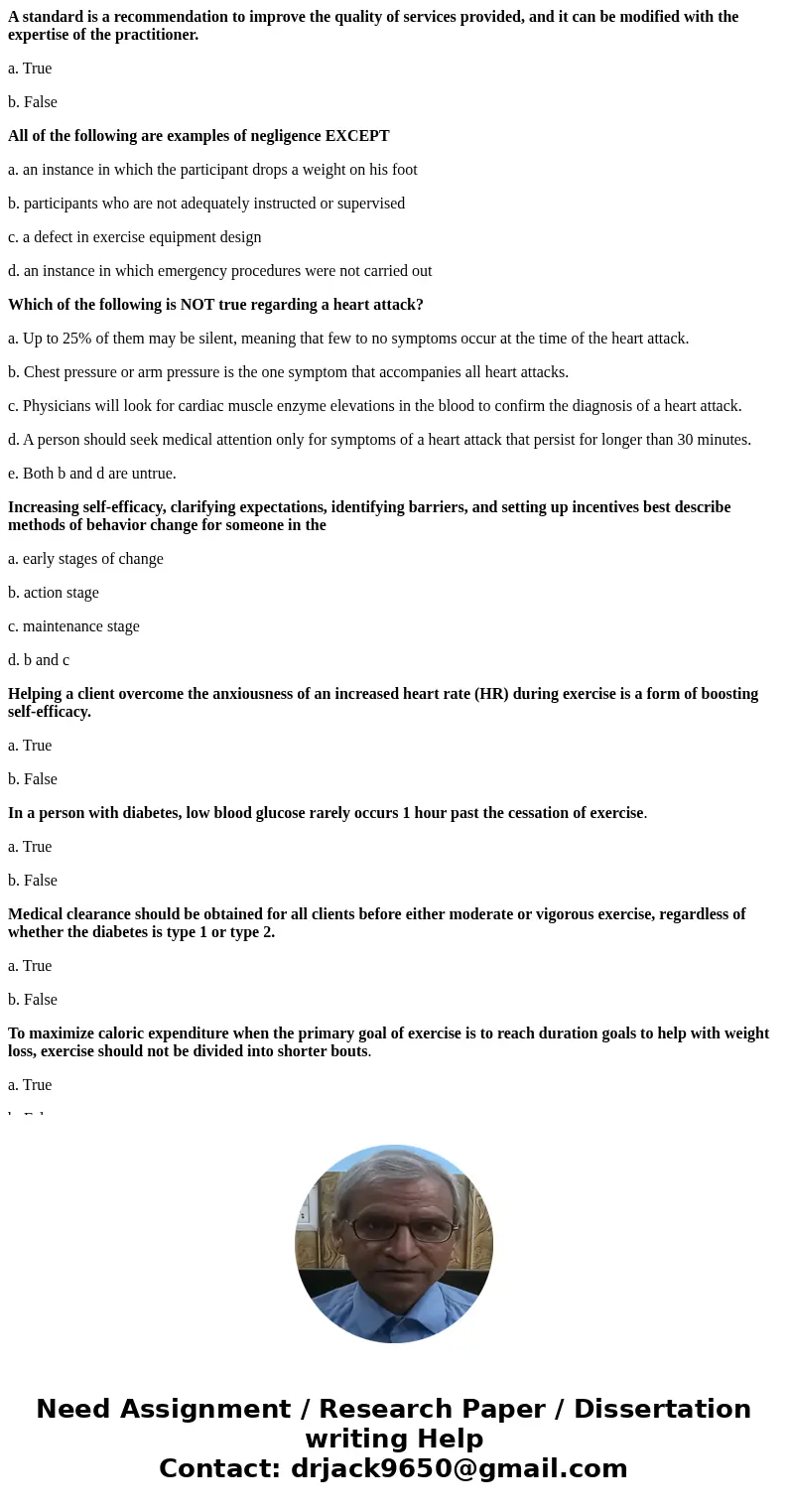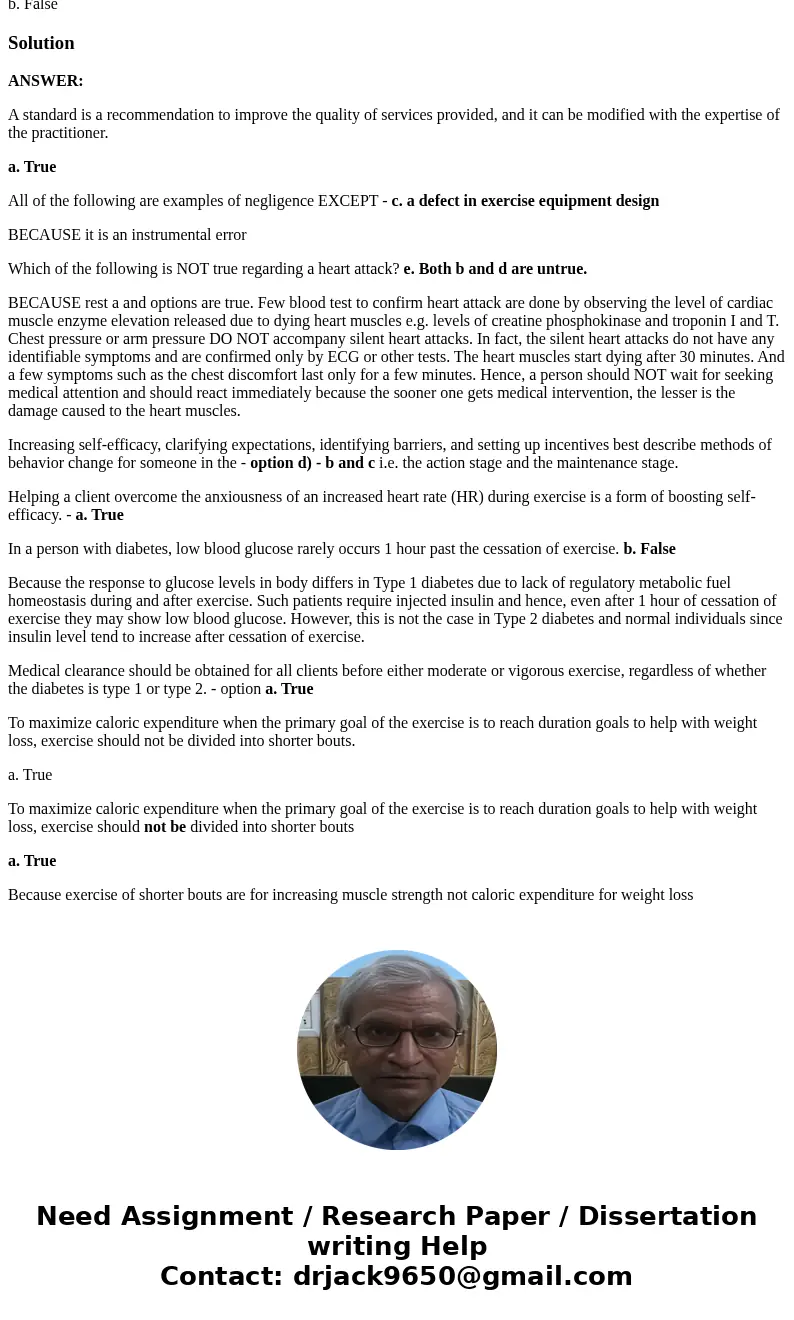A standard is a recommendation to improve the quality of ser
A standard is a recommendation to improve the quality of services provided, and it can be modified with the expertise of the practitioner.
a. True
b. False
All of the following are examples of negligence EXCEPT
a. an instance in which the participant drops a weight on his foot
b. participants who are not adequately instructed or supervised
c. a defect in exercise equipment design
d. an instance in which emergency procedures were not carried out
Which of the following is NOT true regarding a heart attack?
a. Up to 25% of them may be silent, meaning that few to no symptoms occur at the time of the heart attack.
b. Chest pressure or arm pressure is the one symptom that accompanies all heart attacks.
c. Physicians will look for cardiac muscle enzyme elevations in the blood to confirm the diagnosis of a heart attack.
d. A person should seek medical attention only for symptoms of a heart attack that persist for longer than 30 minutes.
e. Both b and d are untrue.
Increasing self-efficacy, clarifying expectations, identifying barriers, and setting up incentives best describe methods of behavior change for someone in the
a. early stages of change
b. action stage
c. maintenance stage
d. b and c
Helping a client overcome the anxiousness of an increased heart rate (HR) during exercise is a form of boosting self-efficacy.
a. True
b. False
In a person with diabetes, low blood glucose rarely occurs 1 hour past the cessation of exercise.
a. True
b. False
Medical clearance should be obtained for all clients before either moderate or vigorous exercise, regardless of whether the diabetes is type 1 or type 2.
a. True
b. False
To maximize caloric expenditure when the primary goal of exercise is to reach duration goals to help with weight loss, exercise should not be divided into shorter bouts.
a. True
b. False
Solution
ANSWER:
A standard is a recommendation to improve the quality of services provided, and it can be modified with the expertise of the practitioner.
a. True
All of the following are examples of negligence EXCEPT - c. a defect in exercise equipment design
BECAUSE it is an instrumental error
Which of the following is NOT true regarding a heart attack? e. Both b and d are untrue.
BECAUSE rest a and options are true. Few blood test to confirm heart attack are done by observing the level of cardiac muscle enzyme elevation released due to dying heart muscles e.g. levels of creatine phosphokinase and troponin I and T. Chest pressure or arm pressure DO NOT accompany silent heart attacks. In fact, the silent heart attacks do not have any identifiable symptoms and are confirmed only by ECG or other tests. The heart muscles start dying after 30 minutes. And a few symptoms such as the chest discomfort last only for a few minutes. Hence, a person should NOT wait for seeking medical attention and should react immediately because the sooner one gets medical intervention, the lesser is the damage caused to the heart muscles.
Increasing self-efficacy, clarifying expectations, identifying barriers, and setting up incentives best describe methods of behavior change for someone in the - option d) - b and c i.e. the action stage and the maintenance stage.
Helping a client overcome the anxiousness of an increased heart rate (HR) during exercise is a form of boosting self-efficacy. - a. True
In a person with diabetes, low blood glucose rarely occurs 1 hour past the cessation of exercise. b. False
Because the response to glucose levels in body differs in Type 1 diabetes due to lack of regulatory metabolic fuel homeostasis during and after exercise. Such patients require injected insulin and hence, even after 1 hour of cessation of exercise they may show low blood glucose. However, this is not the case in Type 2 diabetes and normal individuals since insulin level tend to increase after cessation of exercise.
Medical clearance should be obtained for all clients before either moderate or vigorous exercise, regardless of whether the diabetes is type 1 or type 2. - option a. True
To maximize caloric expenditure when the primary goal of the exercise is to reach duration goals to help with weight loss, exercise should not be divided into shorter bouts.
a. True
To maximize caloric expenditure when the primary goal of the exercise is to reach duration goals to help with weight loss, exercise should not be divided into shorter bouts
a. True
Because exercise of shorter bouts are for increasing muscle strength not caloric expenditure for weight loss


 Homework Sourse
Homework Sourse